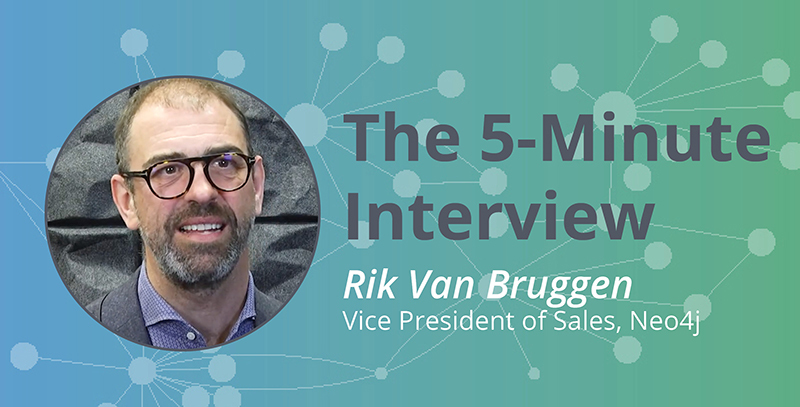An Explosion of Use Cases: 5-Minute Interview with Rik Van Bruggen

Product Marketing Manager, Neo4j
5 min read

“I think the performance and the security features are really going to open up new types of applications. That’s the beauty of working in an open core company like Neo4j,” said Rik Van Bruggen, Vice President for Sales, Neo4j.
In this week’s five-minute interview (conducted at GraphTour Stockholm 2019), we talk with Rik Van Bruggen about how the latest features in the Neo4j graph database are going to spawn a whole series of new applications.
What has been the biggest change you’ve seen in the graph landscape over the last few years?
I think the change has been the overall maturity of the product set and of the platform that we’ve built. When I started, we were at version 1.7 and it was a difficult product to use.
Today, that’s completely changed, not just with the core database, but with all the tooling around it. If you look at Neo4j Desktop, the Neo4j Browser, the plug-ins, and all the graph algorithms, all of it has matured unbelievably, making it so much more accessible to a wider audience. That’s a huge difference.
The graph market is extremely vibrant and innovative, and the product quality is also extremely consistent.
It’s also fascinating to see the company grow. I have a staff picture at home and everyone fits in one picture, and that would not be possible today at Neo4j. The company has grown so much. That’s really cool to see.
What is most exciting about Neo4j’s 4.0 release?
There are basically three big parts, I would say. One is all about scalability. The vast majority of our users don’t need exorbitant scale, but they also don’t want to be limited by scale.
We’ve put in place Neo4j Fabric. We can say, “We’ve got you. We can work with you at small-scale, medium-scale and high-scale.”
Another part, which I think is really exciting, is multitenancy: the ability to run more than one workload on a particular server. That’s a little bit of a catch-up toward other database technologies. We’ve had to do crazy workarounds to be able to achieve the same thing, and now it’s just a click. It’s really easy.
And the last area is security. I spent more than 10 years of my life in the security industry, and what we have done with Neo4j 4.0 and the fine-grained security capabilities it has is just fantastic. It really blows your mind.
Even a salesman like me can get their head around it and see the value of it. Simple examples of being to shield specific data from specific users, but then also to shield specific patterns from specific users, specific traversals across the graph that some users might see and some users might not see.
It’s extremely powerful to be detailed and prescriptive, and I haven’t seen anyone in the data industry do anything like it. We’re innovating and we’re leading there, and that’s really fascinating.
How do you see the latest features impacting Neo4j users?
I think the performance and the security features are really going to open up new types of applications. And that’s the beauty of working in an open core company like Neo4j.
Our users are going to dream up scenarios that we haven’t thought about yet. That’s just the way it’s supposed to work, actually. Some of the obvious candidates are new types of analytical applications that people are going to be able to do analysis that they weren’t able to do before using these types of technologies.
The other thing is that they’re going to be able to do things faster. They’re going to be able to do things in real time that used to take hours, weeks or months. I think that will spawn a whole series of new applications.
I think our most common use cases are pretty well-known by now, things like recommendation engines, fraud detection systems, data lineage systems and Customer 360. We know where graphs shine, and now we’re going to be able to do that at a much greater scale and in a more secure way. That’s what I see.
What is in store for the future of graph technology?
I think in the next few years we will see not just adoption of graph technology, but applying graph modeling to a much wider range of use cases.
Graphs are everywhere, whether you believe it or not. People have been treating this as a niche technology for a very long time, and in the next phase, it’s going to expand.
People who are building shopping cart systems are all of a sudden going to say, “Hey, my shopping cart is connected to this thing and that thing. It’s a graph. Why would I develop my shopping cart in a relational system? I’m going to do it in Neo4j, because the next phase is going to be graphs.”
I really think this is the phase where we’re going to see an explosion of use cases. And that’s very exciting because, as we saw at GraphTour Stockholm, and there’s still a lot of people who need to be immersed in this stuff. They are new to it, they are blown away by it and they see the possibilities of it. And we’re going to see a lot more of that.
Do you have any advice for people starting out in graphs?
Don’t go it alone. Graphs are peculiar in a way; they are so easy for us to think about, to reason about and to work with, but they take a little of getting used to. It’s just the way it is.
I graduated from university a very long time ago, but I would never have gotten my degree if I didn’t think in tables. That was necessary at the time. And there’s a plethora of people who have the same problem, and they need to unlearn that in order to relearn a data model that’s actually much more convenient and a lot more natural.
If you do that on your own, chances are very high that you will succeed, but it might take you a little bit longer. Reach out and just talk to us about it.
One of the coolest things that we have done as a company is that we’ve balanced commercial activities with open source and community activities. We’ve done a really good job at that. There’s a community that you can get involved in, that you can reach out to, that you can ask for help, but there’s also a company that you can ask for help. And it’s a very important thing to do.
Don’t sit in your corner and get frustrated because this thing doesn’t work the way you want it to work. Just ask someone who’s done it before, like a community member or reach out to Neo4j directly.
Want to share about your Neo4j project in a future 5-Minute Interview? Drop us a line at content@neo4j.com








